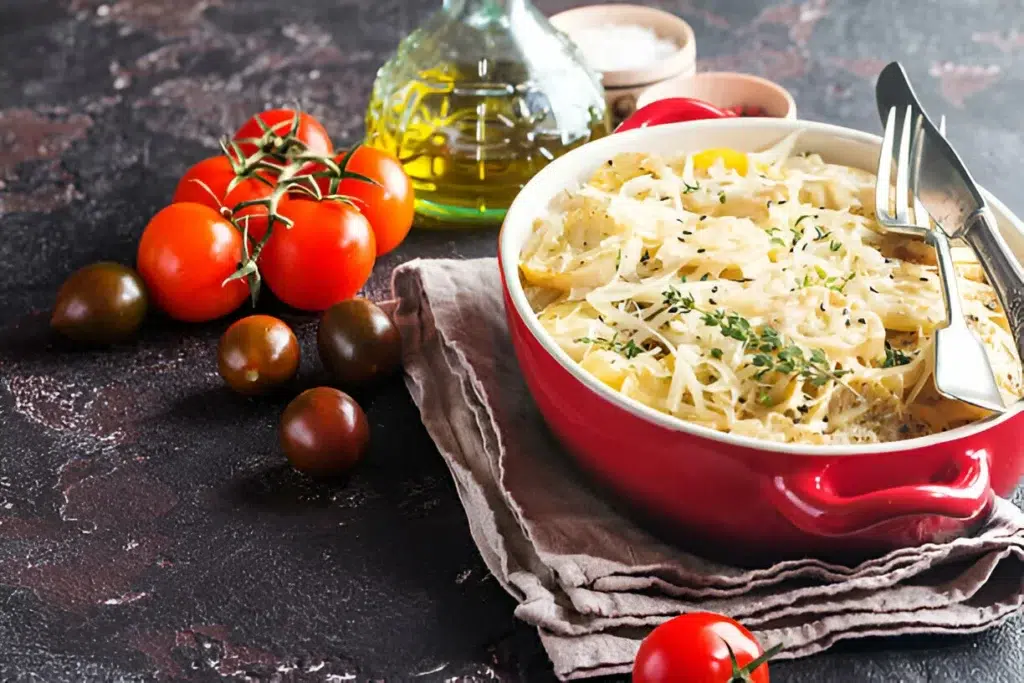
Dive into Mafaldine: The Regal Ribbon on Your Plate
Mafaldine, a wide ribbon pasta with ruffled edges, isn’t just delicious—it’s a looker! But its name whispers of royalty, hinting at a deeper story. Understanding mafaldine’s history and the origin of its name unlocks a new appreciation for this versatile pasta.
Get ready for a culinary adventure! We’ll explore the best cooking techniques and mouthwatering pairings for mafaldine while also diving into the cultural significance of this unique shape. Dive into the story and culinary delights of the regal mafaldine.
A Princess and her ruffled pasta: Unveiling Mafaldine’s Royal Lineage
Mafaldine’s name whispers of royalty, sparking immediate intrigue about its fascinating past. Let’s delve into the story behind this regal ribbon.
Princess Mafalda of Savoy:
Our journey starts with Princess Mafalda of Savoy (1896–1944). The eldest daughter of King Vittorio Emanuele III of Italy, she was a strong-willed and intelligent woman. In 1919, she married Prince Philipp of Hesse. Tragically, their lives became entangled with the rise of fascism in Europe. Philipp, a German prince, found himself on the opposite side of World War II. The Nazis eventually imprisoned the couple and their children.
From Manfredine to Mafalda:
While the exact details are unclear, historical accounts point to a pasta shape known as “manfredine” existing before Princess Mafalda’s time. Some believe it originated in Naples, Italy, possibly named after a regional lord or another historical figure. However, sometime in the early 20th century, “manfredine” gracefully morphed into “mafaldine.”
A Royal Touch:
The exact reason for this shift remains up for debate. Some theories propose it was a deliberate tribute to the popular princess, a way to imbue the pasta with an air of elegance and sophistication. The name change could also be simply a natural linguistic evolution.
Regardless of the precise reason, the association with Princess Mafalda undeniably elevated the status of this pasta shape. It became linked with celebratory meals and special occasions, further solidifying its place in Italian culinary traditions.
Kings, queens, and other noble figures have actively influenced food throughout history. They have lent their names to dishes and ingredients. This practice not only added prestige but also served as a way to commemorate these influential individuals. In the case of mafaldine, the royal connection adds a layer of intrigue and history to this delicious pasta.
The Regal Ribbon Unfurled: Exploring Mafaldine’s Form and Function
Mafaldine’s elegance extends far beyond its name. Let’s delve into its physical characteristics and see how they contribute to its culinary magic.
A Feast for the Eyes:
Imagine a wide ribbon of pasta, roughly 1–1.5 cm wide, with playful ruffled edges dancing along its length. This is mafaldine in all its glory. These ruffles aren’t just for show; in fact, they play a crucial role, capturing and holding sauce for a delightful experience in every bite.
Sibling Shapes:
While unique, mafaldine shares some similarities with other beloved pasta shapes. For instance, fettuccine boasts a similar wide ribbon form but lacks the characteristic ruffled edges. Additionally, tagliatelle, another close relative, is slightly thinner and features straight edges. Understanding these similarities helps you choose the perfect pasta for your desired outcome.
From Dough to Delight:
Traditionally, artisans craft mafaldine with semolina flour, a coarse flour made from durum wheat. They meticulously knead the dough until it is smooth and elastic, then roll it out into thin sheets. A special pasta machine equipped with a mafaldine mold cuts the dough into its signature wide ribbons. This traditional method ensures a consistent texture and “al dente” cooking experience.
Modern Twists:
Today, however, modern machinery complements these artisanal methods, allowing for large-scale mafaldine production. Automated pasta machines efficiently create the signature shape, ensuring consistent quality and wider availability. Furthermore, some modern variations incorporate eggs into the dough for a richer flavor or use alternative flours for gluten-free options.
A Cultural Tapestry: Unveiling the Significance of ruffled pasta
Mafaldine’s journey extends beyond the kitchen. This unique pasta shape holds a special place in Italian culinary traditions, particularly in its birthplace of Naples and across Southern Italy.
A Neapolitan Gem
Neapolitan artisans crafted mafaldine, shaping it into its wide, ruffled form that became deeply woven into the city’s cultural fabric. These playful edges added a touch of artistry and uniqueness to the dish. The name “Mafaldine,” while not directly translating to Italian, is believed to be inspired by Princess Mafalda of Savoy. This royal association adds a touch of elegance and elevates the pasta to a celebratory status, often gracing special occasions.
Symbolism and Modern Relevance
The shape of mafaldine itself carries symbolic meaning. The wide, ruffled edges are more than just aesthetically pleasing; they act as a “catch-all” for sauce, ensuring each bite bursts with flavor. In essence, it embodies the Italian approach to pasta—a perfect marriage between form and function, maximizing enjoyment with every mouthful.
A Modern Renaissance
Today, mafaldine remains a beloved pasta shape across Italy. Its versatility empowers chefs to be creative. Whether used in classic Neapolitan pairings with light sauces or seafood or starring in bold, contemporary creations with robust ragùs or spicy sausage, mafaldine continues to be a testament to Italian culinary ingenuity.
Adding to its cultural significance, some regions in southern Italy have developed their own unique traditions around mafaldine. In Puglia, for instance, it’s sometimes used to represent St. Joseph’s beard on his feast day.
A Culinary Canvas: Exploring Popular ribbon pasta Dishes
Mafaldine’s versatility shines not only in its ability to pair with various sauces but also in its role as a canvas for traditional and contemporary creations. Let’s delve into some popular dishes that showcase its culinary potential.
A Taste of Tradition:
Naples & Beyond:
Hailing from Naples, mafaldine takes center stage in classic Southern Italian dishes. For instance, “Mafaldine al Ragù” features a rich, slow-cooked meat ragu that clings perfectly to the pasta’s ruffles. This hearty dish is true comfort food, bursting with flavor in every bite.
Sicilian Sunshine:
Venturing further south, we encounter “Mafaldine con le Melanzane” (with eggplant) in Sicily. Here, pan-fried or roasted eggplant bathes in a light tomato sauce, creating a vibrant and flavorful vegetarian option. The textural contrast between the soft eggplant and the al dente pasta adds another layer of delight.
These are just a few examples, and regional variations abound. From creamy seafood sauces to simple garlic and olive oil pairings, mafaldine readily adapts to local ingredients and traditions.
Modern Twists:
Today’s chefs aren’t afraid to experiment with this versatile pasta. Bold interpretations like “Mafaldine al Pesto Rosso” (with Red Pesto) add a vibrant twist, featuring sun-dried tomatoes and roasted red peppers for a deeper flavor profile.
On the other hand, for a lighter option, “Mafaldine Primavera” showcases the beauty of fresh seasonal vegetables. Asparagus, peas, and cherry tomatoes tossed with a simple lemon sauce create a vibrant and flavorful dish.
These contemporary creations demonstrate Mafaldine’s ability to evolve with culinary trends while staying true to its delicious Italian roots.
Whether enjoyed in a classic preparation or a modern interpretation
mafaldine offers a delightful culinary experience, ensuring its place as a beloved pasta shape for generations to come.
Mafaldine FAQs: Exploring the Unique Pasta
Q: What sets Mafalda pasta apart from other types?
Mafaldine stands out due to its wide, ribbon-like shape with playful ruffled edges. These ruffles help capture more sauce, enriching every bite with flavor. In contrast, fettuccine has a smooth surface, and tagliatelle is narrower and smoother, making mafaldine’s texture unique.
Q: Why do people associate Princess Mafalda with this pasta?
A: The connection between Princess Mafalda of Savoy and this pasta is intriguing but unclear. It is believed that “manfredine” pasta was renamed “mafaldine” as a tribute to the princess in the early 20th century. This royal nod likely enhanced the pasta’s image, associating it with special and luxurious meals.
Q: How do regional cooking techniques for mafalda pasta differ in Italy?
Mafaldine showcases regional diversity effectively. In Naples, chefs often use it in “Mafaldine al Ragù,” combining it with a rich meat sauce. Meanwhile, Sicilian cooks prepare “Mafaldine con le Melanzane,” pairing the pasta with pan-fried eggplant and a light tomato sauce. These variations across Italy highlight local ingredients and culinary traditions, proving mafaldine’s versatility.
A Farewell to the Regal Ribbon: A Celebration of ribbon pasta
This exploration of mafaldine has unraveled its story, from its playful, ruffled form to its cultural significance. We’ve delved into its Neapolitan roots, its unique ability to capture sauce, and its versatility across various dishes.
A Legacy of Flavor:
Mafaldine’s enduring popularity lies in its ability to bridge tradition and innovation. It serves as a canvas for classic comfort food like ragù while also embracing modern twists with bold pestos and seasonal vegetables. This adaptability, coupled with its delightful texture and ability to hold onto sauce, makes it a beloved pasta shape across generations.
A Final Note:
Whether enjoyed in a traditional Neapolitan dish or a contemporary creation, mafaldine offers a delightful culinary experience. So, the next time you’re looking for a delicious and versatile pasta, consider the regal ribbon—the mafaldine.
References:
- The Oxford Companion to Italian Food: https://global.oup.com/academic/product/the-oxford-companion-to-italian-food-9780198606178 (official publication of Oxford University Press)
- The International Pasta Organization: https://internationalpasta.org/ (industry association for the pasta industry)
- The National Italian American Foundation: https://www.niaf.org/ (promotes Italian culture and heritage)
Related Articles
For readers interested in exploring more about pasta varieties and related recipes, here are some internal linking opportunities that complement the article on “Why is it called Mafalda pasta?”:
- Mafaldine Pasta: Dive deeper into the specifics of Mafaldine pasta, exploring its unique characteristics and culinary uses. This article offers a focused look at one of the intriguing varieties discussed in the main article.
- What is the Difference Between Mafaldine and Reginette?: Expand your pasta knowledge by understanding the subtle differences and similarities between Mafaldine and its close relative, Reginette. This comparison will enhance your appreciation of pasta shapes and their specific applications.
- Delicious and Nutritious Air Fryer Mushroom Recipes: While slightly off the main topic, this article offers a delightful exploration of using air fryers to prepare healthy recipes, including potential pairings with Mafaldine pasta for a complete meal.
